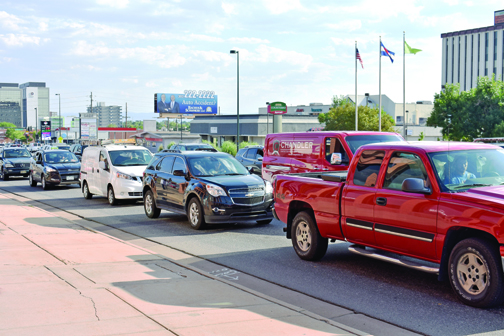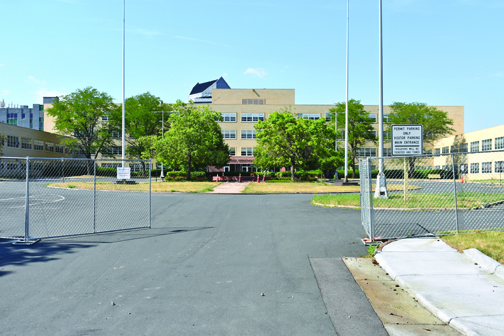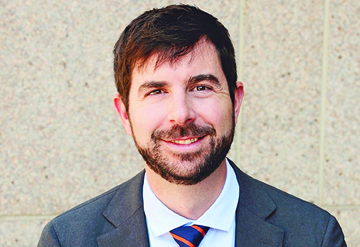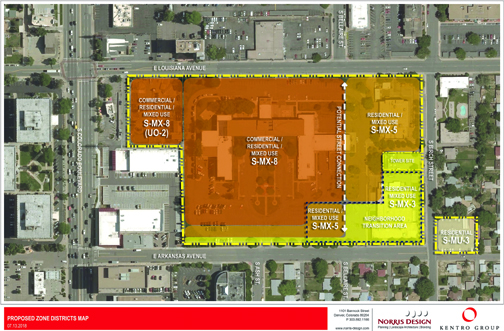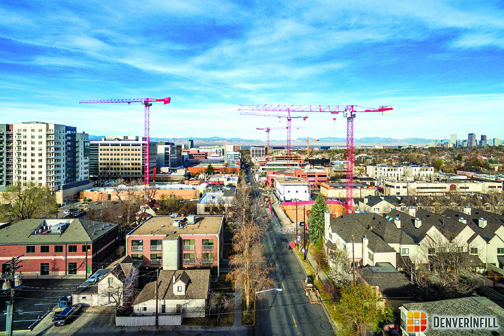
City’s Curse Of Excessive Construction Is Cutting Business, Crushing Valley Lifestyle
Councilman New Drafts Construction Management Ordinance, Says Size, Complexity Exceed City’s Ability Or Will To Control
by Glen Richardson
Denver is undergoing its largest construction boom in modern times with Cherry Creek North at the epicenter. Like a jackhammer the excessive construction is causing serious detrimental effects to surrounding businesses, residents and visitors. Moreover, the construction trend is on the rise in adjacent neighborhoods plus sections of downtown.
“The lack of support and assistance to small business retailers and neighborhood residents by development owners, construction management, construction workers and Denver Public Works justifies the need for stronger construction management policies by the City,” concludes City Councilman Wayne New. Council members Albus Brooks with his similar construction problems in RiNo and Paul Kashmann with the same issues in his neighborhoods have been supportive to the proposed changes.
The first term councilman, who is also a Cherry Creek North resident, say he has determined that “a City Council ordinance is required to enhance existing Public Works construction management policies that will manage construction projects more efficiently and effectively.” He tells the Chronicle it is his hope such an ordinance will mitigate the trials and tribulations businesses and residents in Cherry Creek have experienced for the past three years. “The ordinance will give Public Works greater flexibility to manage projects of varying size and complexity.” While the focus is on Cherry Creek construction he adds, “these recommendations can and should be applicable to construction project in all city areas.”
Collapse At Public Works
The number of Cherry Creek North construction projects that have been initiated simultaneously and in a relatively short period of time is staggering: The district has seen four major projects completed, 10 are underway, plus two to three new projects are set to begin within the next 12 months. Those construction projects don’t take into account rhe ones completed or under construction in the contiguous Cherry Creek East and Golden Triangle areas.
Impact of the Cherry Creek construction volume has been a serious blow to district parking. Moreover, New notes that the implementation of paid parking at the Cherry Creek Shopping Center has increased district customer and neighborhood parking concerns.
“There is no doubt now that the problems have resulted from Public Works’ inability to require pre-permitting and pre-construction planning and construction management agreements regarding area traffic flow, street closures, parking meter management, defined offsite parking arrangements, noise mitigation, trash prevention and collection.”
Sending Wrong Message
The lack of routine and timely construction meetings with the involvement of all parties has also hindered critical discussion on construction project issues and plans, according to New.
Such meetings, he believes, “would have prevented or mitigated problems and difficulties for businesses and residents before they occurred.”
The inability of construction companies and city officials to address these problems and issues has discouraged the desire of shoppers and business customers to visit areas where construction is underway. Furthermore, New bemoans, “It has sent a citywide message to avoid Cherry Creek and its construction problems.” The impact, he says is clear: “Small business retail sales have declined, residential quality of life disrupted and neighborhood parking hindered.”
Many small businesses have either closed or are struggling to stay in business. Cherry Creek residents are questioning whether the traffic congestion, traffic flow disruptions and parking limitations will decrease or can be managed. Thus many residents are contemplating if remaining in the neighborhood will be possible or desirable.
Steps To Improvement
 The ordinance being drafted by Councilman New has more than a dozen recommendations for improvements. They are being created now because as New asserts, “It is very apparent they are required to strengthen current City construction management policy and provide additional policies for improvement.”
The ordinance being drafted by Councilman New has more than a dozen recommendations for improvements. They are being created now because as New asserts, “It is very apparent they are required to strengthen current City construction management policy and provide additional policies for improvement.”
Top of the list is the issue of Excessive Construction within a Defined Area. Reason: The compounding effects of excessively large volumes of work have caused extreme hardships on surrounding businesses, residents, visitors and others within the area. Recommendation: When multiple projects are initiated that impact pedestrian safety and traffic management Public Works will strictly enforce policies and procedures to balance and mitigate effects on commercial and residential communities. This includes strict sidewalk protections; limit the permitting of street-lane closures and temporary one-way streets that grant favorable treatment to construction projects.
The Councilman also believes that Planning, Communication & Notification must be compulsory. Reason: Business and community leaders are not involved in project discussions. Moreover, there is insufficient notification to all parties when activities affecting business operations and traffic flow will occur. Recommendation: Full street closures for an extensive time period will not be allowed. Closure of a street for up to three days may be considered for safety reasons. A graduated fee per day would be imposed on contractors failing to end approved closures.
Added Reform Measures
These additional reforms, condensed for publication, are included in the ordinance being drafted by New:
Pedestrian Sidewalks: If construction occurs on a block, one side of the street must be open. When construction occurs on both sides of the street, a wooden covered walkway must be installed on at least one side of the project. Walkways must be sturdy, waterproofed and adequately lighted for nighttime use.
Construction Worker Parking: A defined plan for every project must be submitted to Public Works prior to receiving a building permit. Contractors must provide an agreement for contracted offsite parking with financial incentives, and penalties for non-compliance. Plan to be forwarded to businesses, neighborhood organization and Council member.
Patch Parking Problems
Parking District Development: Proposed district would operate and fulfill all prescribed City regulations and requirements but would not be responsible for parking meter collections. Management of City parking activities is not currently coordinated and managed by a single City division.
Parking Meters: Use of parking meter bags for construction purposes must be included in pre-construction planning discussions in order to make business and neighborhood leaders aware of any pending disruptions. Meter bagging would not be allowed for more than a continuous three-day period.
Parking Enforcement & Signage: Parking enforcement and ticketing must be performed in all neighborhoods on a regular 2-hour basis. Signage that informs parkers of the proper distance for alley entrances and street intersections must be installed. An implementation and budget plan must be developed for a five-year completion time frame.
Noise, Trash & Traffic
Noise & Trash: Contractors must provide construction site trash and cigarette butt receptacles directly outside of construction sites. Contractors must pay local business organizations for the offsite area collection and removal of trash and cigarette butts daily.
Traffic & Pedestrian Signage: Contractors must remove all traffic and pedestrian management signs, cones and barricades from the public right-of-way within 24-hours when not in use.
Coordination With City & Business Guidelines: Recommendations for improvement must be coordinated with existing construction mitigation plans and business area guidelines. Differences should be reconciled and final improvements guided by their efficiency, effectiveness, balance and greatest positive impact.
Construction Epicenter: Towering cranes over Cherry Creek hint at the number of construction projects that have been initiated. The district has seen four major projects completed, 10 are underway, plus two to three new projects are set to begin within the next 12 months.
Denver City Councilman Wayne New
Street Shutdown: Cherry Creek North street closures are damaging business operations and disrupting traffic flow. One block of Saint Paul St. where a bank and other businesses are located was closed for two months.
Lack Of Planning: By not communicating and coordinating construction activities Public Works contributes to the lack of community notice and inability to mitigate business operational problems.
Gotta Go Other Way: Temporary one-way street arrangements give favorable treatment to construction projects and have a negative effect on businesses, residents and visitors.
Closed Sidewalk Epidemic: Booming development should bode well for people who walk. In Denver, nevertheless, people are encountering more and more closed sidewalks in construction zones.






